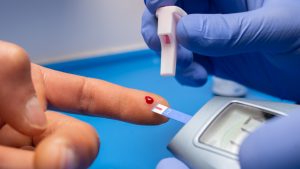Receiving a diagnosis of diabetes can be a turning point in your life, but it doesn’t have to be a roadblock. With the right approach to diet and lifestyle, you can effectively manage your condition and lead a full, vibrant life. Here are some key tips to help you improve your diet and take control of your health after a diabetes diagnosis:
1. Focus on Whole, Nutrient-Dense Foods: Instead of processed foods and refined carbohydrates, prioritize whole, nutrient-dense foods that provide essential vitamins, minerals, and fiber. Opt for whole grains like brown rice, quinoa, and oats, lean proteins such as poultry, fish, tofu, and legumes, and healthy fats from sources like avocados, nuts, and olive oil.
2. Monitor Your Carbohydrate Intake: Carbohydrates can significantly impact blood sugar levels, so it’s essential to monitor your intake and choose wisely. Aim to include carbohydrates from whole, unprocessed sources like fruits, vegetables, and whole grains, and be mindful of portion sizes to avoid spikes in blood sugar levels.
3. Incorporate Plenty of Fruits and Vegetables: Fruits and vegetables are rich in fiber, vitamins, and antioxidants, making them essential components of a diabetes-friendly diet. However, not all fruits and vegetables are created equal when it comes to managing blood sugar levels. Here are some recommendations on fruits and vegetables to include and avoid if you have diabetes:
Fruits to Include:
- Berries: Strawberries, blueberries, raspberries, and blackberries are low in sugar and high in fiber and antioxidants, making them excellent choices for managing blood sugar levels.
- Citrus Fruits: Oranges, grapefruits, and lemons are rich in vitamin C and fiber, with a lower glycemic index compared to some other fruits.
- Apples: With their high fiber content, apples can help regulate blood sugar levels and promote satiety.
Fruits to Avoid or Limit:
- Tropical Fruits: While delicious, fruits like bananas, mangoes, and pineapples are higher in sugar and can cause spikes in blood sugar levels if consumed in large quantities. Enjoy them in moderation and be mindful of portion sizes.
Vegetables to Include:
- Leafy Greens: Spinach, kale, and Swiss chard are low in calories and carbohydrates but rich in nutrients like vitamins A, C, and K.
- Cruciferous Vegetables: Broccoli, cauliflower, and Brussels sprouts are packed with fiber and antioxidants, making them excellent choices for managing blood sugar levels.
- Non-Starchy Vegetables: Bell peppers, cucumbers, and tomatoes are low in carbohydrates and calories but high in essential nutrients, making them ideal for diabetes management.
Vegetables to Limit:
- Starchy Vegetables: Potatoes, sweet potatoes, and corn are higher in carbohydrates and can cause spikes in blood sugar levels if consumed in large quantities. Enjoy them in moderation and be mindful of portion sizes.
4. Stay Hydrated: Drinking plenty of water is essential for overall health and can help regulate blood sugar levels. Aim to drink at least 8 glasses of water per day, and avoid sugary beverages like soda and fruit juices, which can cause spikes in blood sugar levels.
5. Consult with a Registered Dietitian: For personalized guidance on managing your diet and diabetes, consider consulting with a registered dietitian who specializes in diabetes care. They can help you create a customized eating plan tailored to your individual needs and goals.
E4 Helps you:
At E4, we’re dedicated to revolutionizing how people manage type 2 diabetes through our innovative E4 Alive program. Our team of specialists has joined forces to create a comprehensive solution aimed at empowering individuals to take charge of their health journey. With personalized support and resources tailored to each person’s unique needs, we make managing diabetes simpler and more effective than ever before.
E4 Alive offers a range of tools and resources to help you better understand and control your blood sugar levels. Our program provides personalized guidance to create a healthy eating plan and integrate regular physical activity into your daily routine. Plus, you’ll have access to a supportive community of individuals who understand your challenges and are there to offer encouragement and guidance every step of the way.
By joining E4 Alive, you can effectively manage your blood glucose levels, improve long-term glycemic control, reduce your risk of diabetes-related complications, and enhance your overall quality of life. It’s not just a program; it’s an opportunity to reclaim your health and vitality. Ready to start your journey to better health? Visit THIS PAGE to learn more about E4 Diabetes Solutions and the E4 Alive program.
To learn more about E4 Diabetes Solutions and the E4 Alive program, visit THIS PAGE.

Type 2 Diabetes: Is It Really Reversible?
A recent National Geographic article [link] explores how type 2 diabetes could be reversible with the right approaches. This condition, which affects millions of people worldwide, has long been considered a chronic and progressive disease. However, recent research challenges this perception and suggests that with lifestyle changes and the right approach, remission is possible. The

How Do GLP-1 Drugs Compare? A Breakdown of Ozempic, Mounjaro, and Trulicity
GLP-1 receptor agonists have revolutionized diabetes management, with drugs like Ozempic, Mounjaro, and Trulicity leading the market. But how do these medications compare in terms of effectiveness, side effects, and patient outcomes? Let’s explore their differences and what they mean for diabetes patients. Understanding GLP-1 Medications GLP-1 receptor agonists mimic a natural hormone that helps

Why Has Medicare Spending on Diabetes Medications Skyrocketed in 5 Years?
In the past five years, Medicare spending on diabetes medications has increased nearly fivefold, reaching $35.8 billion in 2023. This surge has been primarily driven by the growing use of GLP-1 drugs such as Ozempic, Mounjaro, and Trulicity. But what is behind this cost escalation, and how does it affect patients and the U.S. healthcare

The Gut Microbiota and Blood Sugar Control: A Hidden Connection
The human gut is home to trillions of bacteria that play a crucial role in digestion, immune function, and even metabolism. Recent research has revealed a fascinating link between the gut microbiota and blood sugar regulation, shedding light on how the balance of microbes in our intestines can influence diabetes risk and overall metabolic health.

The Dawn Phenomenon: Why Blood Sugar Rises While You Sleep
For many people with diabetes, waking up with high blood sugar levels can be frustrating—especially if they didn’t eat anything overnight. This early-morning spike in blood glucose is known as the Dawn Phenomenon, and it happens due to natural hormonal changes in the body. But why does it occur, and how can it be managed?

The Influence of Red Light on Blood: Can It Improve Diabetes?
Type 2 diabetes is a metabolic disease characterized by insulin resistance and elevated blood glucose levels. In the search for complementary alternatives to improve glycemic control, red light therapy has gained attention due to its potential to enhance circulation, reduce inflammation, and optimize cellular function. But what does science say about it? ✨ What is

